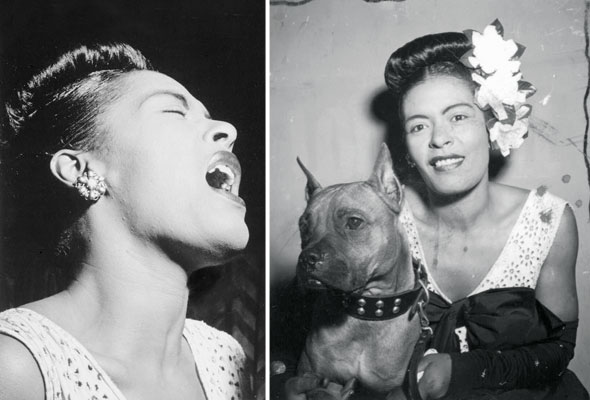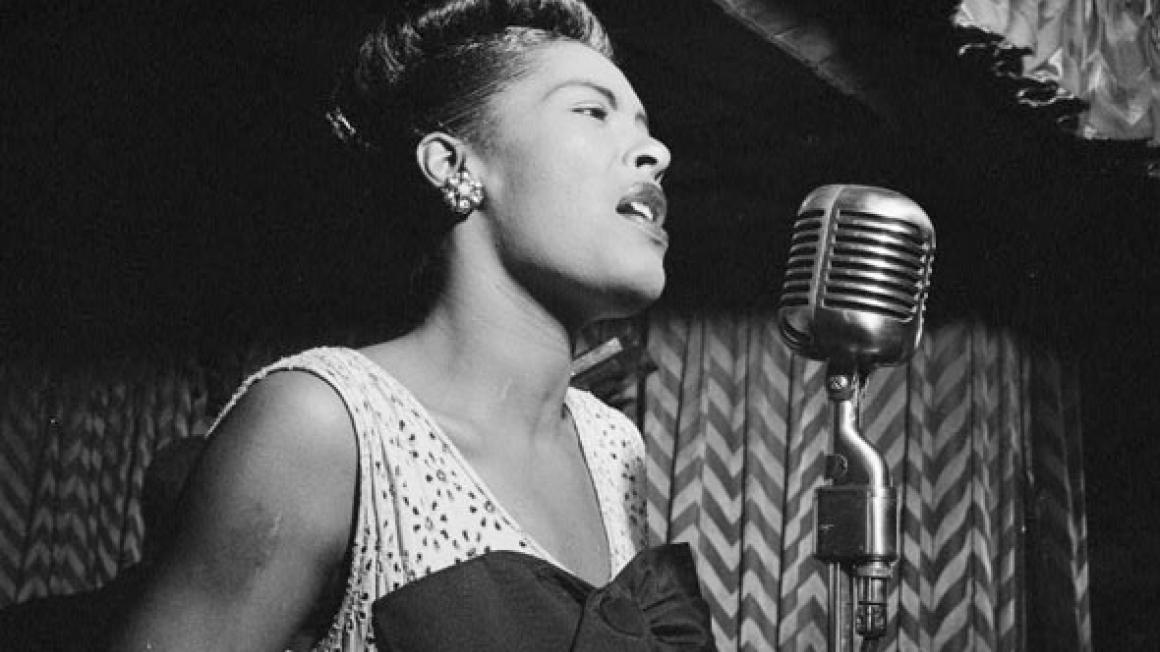Lady Sings the Blues
According to more recent revelations, when Billie was born on 7 April 1915 in Philadelphia General Hospital, her Mom was actually 19, while Pop was 16. So if they married three years after Billie was born they were 22 and 19, respectively.
Mom’s name was Sarah, known as Sadie; Pop was Clarence, and they named their daughter Eleanor, later to become Eleanora.

Hers was a childhood and adolescence tainted by neglect and domestic disruption. Little Eleanora ran errands for the girls in the brothel on the corner, rewarded by being allowed to listen to the records of Louis Armstrong and Bessie Smith. From the age of 10 she was in trouble with the authorities, picked up for truancy and vagrancy. She even served time for prostitution.
And then she became Billie. She had been working as a waitress, singing for tips in various New York bars and restaurants, and took the name from a star of the silent screen. ‘I don’t think I missed a single picture Billie Dove ever made. I was crazy for her. I tried to do my hair like her, and eventually I borrowed her name,’ she said at the time. Holiday she took from her banjo-playing father.
Father he may have been, but never much of a father figure and next to no help to Sadie. Billie confronted him one night at the Roseland Ballroom where he was playing in the Fletcher Henderson band. She was about 15 then, but according to her, ‘I looked plenty old enough to vote’. He pleaded with her not to call him Daddy in front of the band. ‘I’m going to call you Daddy all night unless you give me some money for the rent,’ she recalled.
One day John Henry Hammond Jr, the wealthy jazz enthusiast and promoter, heard Billie sing. ‘I heard something new and completely fresh, the phrasing, the sound of an instrumentalist,’ he declared. He took the legendary Benny Goodman to hear her, and then arranged a recording session. It was 1933 and she was only 18 years old. ‘When we got there I saw this big old microphone, it scared me half to death.’ Besides Goodman on clarinet the band included two other giants of jazz, trombonist Jack Teagarden and drummer Gene Krupa.
The song she sang was a trifle called My Mother’s Son-in-Law (persistently wrongly billed as Your Mother’s Son-in-Law).
‘You don’t have to have a hanker
To be a broker or a banker
No siree, just simply be
My mother’s son-in-law.’
She was paid $35 for the session. The record went nowhere, but she’d worked with musicians who mattered, She matured musically; two years later she was recording better songs with some of the finest musicians around. Hammond was determined that the world should hear her.

As a mark of personal esteem Billie was nicknamed ‘Lady Day’ by the tenor saxophonist Lester Young. She admired him equally as much and awarded him the nickname ‘Pres’, short for President. Musically, Lady Day and Pres were a perfect complement to each other. The evidence is there on recorded gems such as Me, Myself and I, made in 1937. (The most cheerfully uplifting music I ever encountered at a funeral was their version of Laughing At Life.)
It would be easy to dwell on Billie’s unhappy life, the episodes of petty crime, drink, drugs and male betrayal that punctuate Lady Sings The Blues. Jazz historian Julia Blackburn believes Billie was certainly betrayed by William Dufty, who co-wrote her 1956 autobiography. ‘I think actually that he understood her,’ she says, ‘but he mistreated her in the sense that he was busy making a profit from the book. That book really, really ruined her.’
The poet and critic Philip Larkin certainly understood Billie; it shows in an elegant summary of her particular talent.
‘This talent was unique,’ he wrote, ‘because it showed a singer of popular ballads fitting naturally into a jazz performance… it held a strong emotional commitment to the lyrics, so that the Broadway ballads she sang were transfigured without losing their original appeal.’
In 1954 she appeared in concert at the Royal Albert Hall, together with Jack Parnell & his Orchestra. ‘I saw what looked like a sack of old clothes hanging over the back of a chair,’ Parnell recalled, ‘and I’m afraid that was Billie in the early morning. But anyway we rehearsed and Billie and I got on. We fell in love with each other, became great pals. At lunchtime we were having brandies together and having a real good time.’
But Billie and her pianist spent the rest of the day ingesting other stimulants, through a needle, Jack thought. ‘When it came to the concert she and her pianist were on another planet. They were out of it. What they were doing bore no resemblance to anything we’d rehearsed, giving me the dead needle because it put me in a bad position. She got very aggressive, so did I, and we finished up dead enemies, all in one day.’
Her performances grew weaker, sometimes breathless, yet she claimed her final album, Lady In Satin, which was recorded in 1958, was her favourite. It’s poignant, a hard one to listen to. Larkin described her voice as sounding like ‘burnt paper’.
In the end, drugs won. In hospital in 1959, even on her deathbed, she was arrested and fingerprinted by narcotics agents.
She was just 44 years old.
Paul Barnes’s jazz show is on Radio Essex and other BBC regional stations, Saturdays at 11pm.


